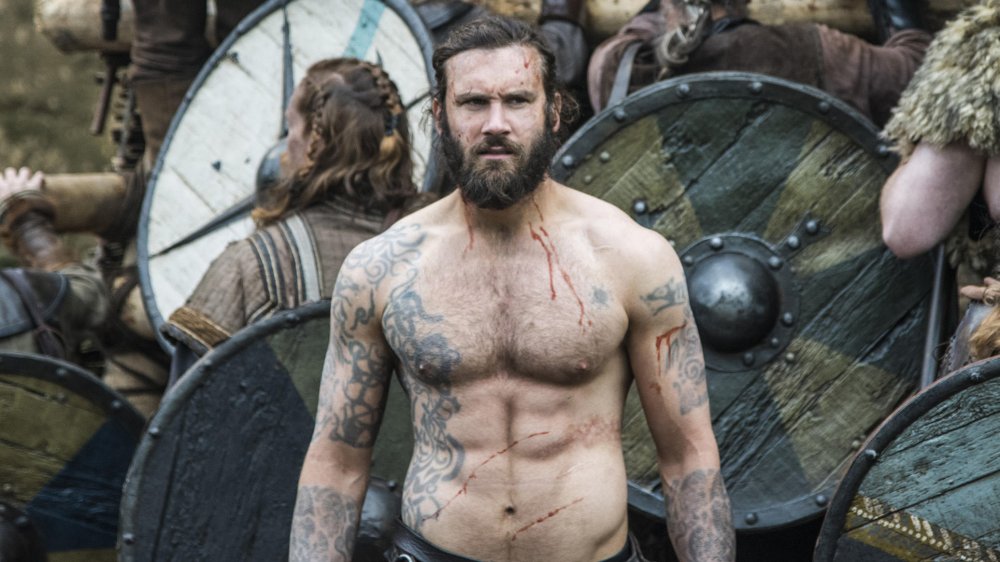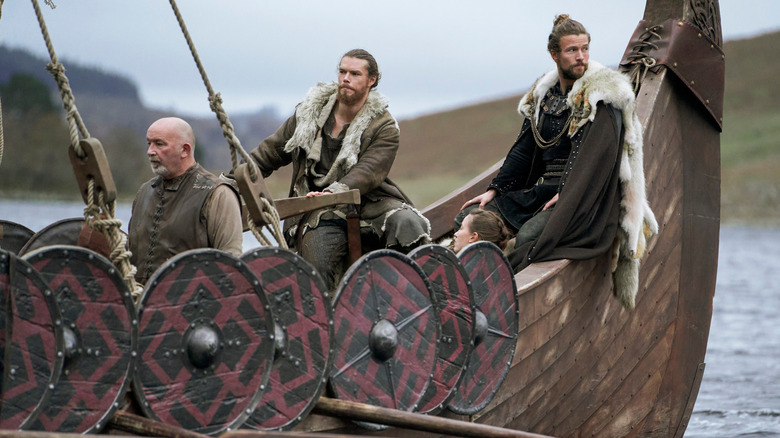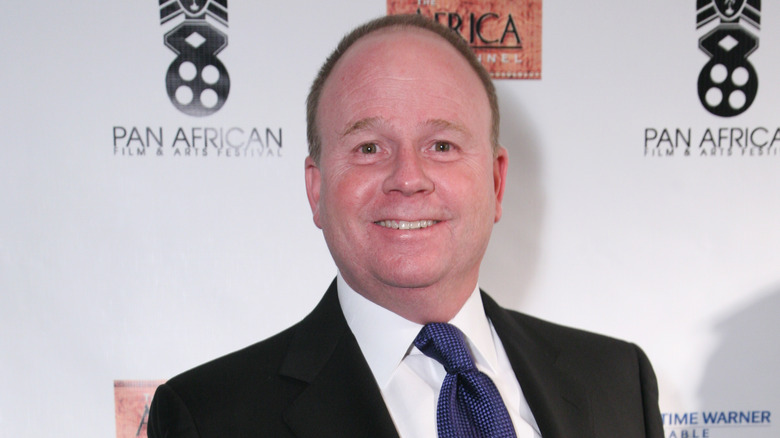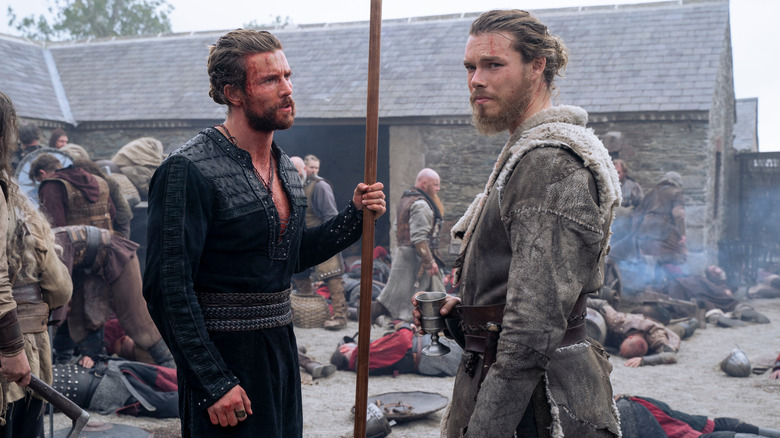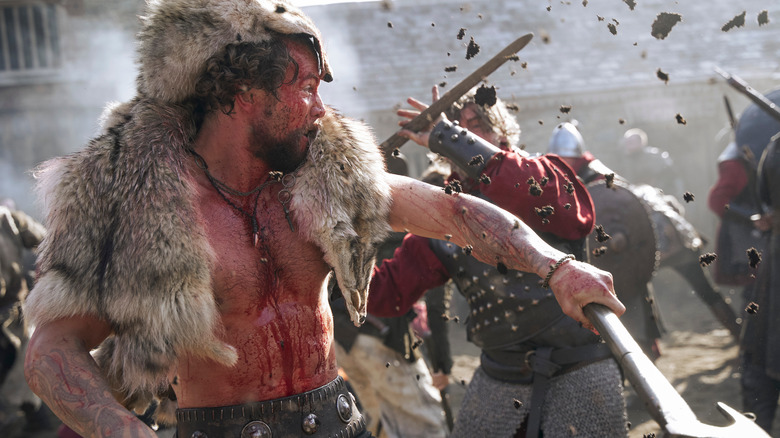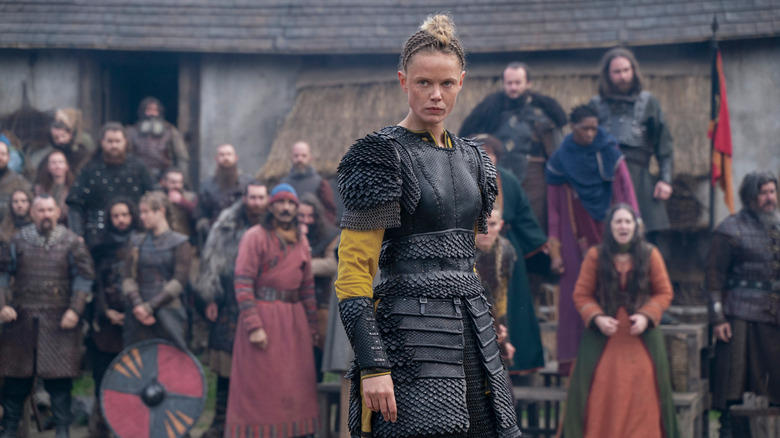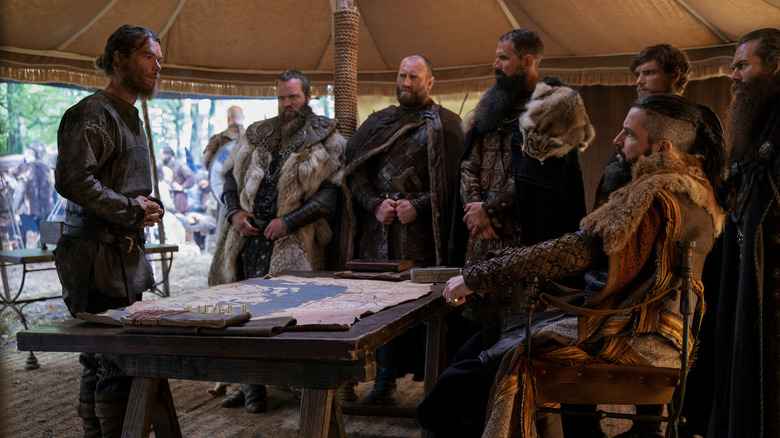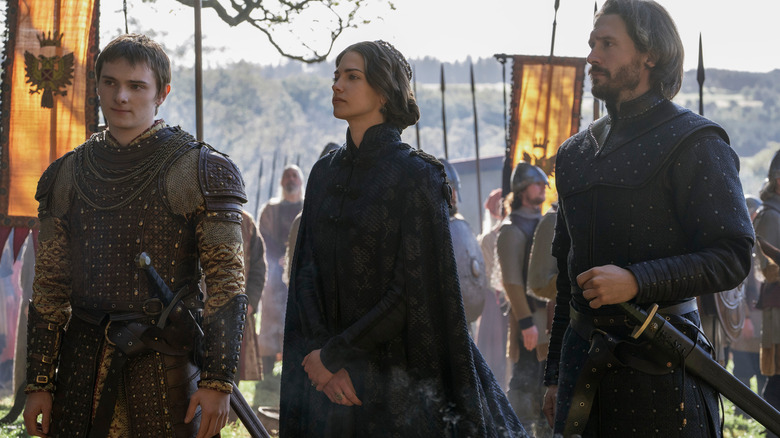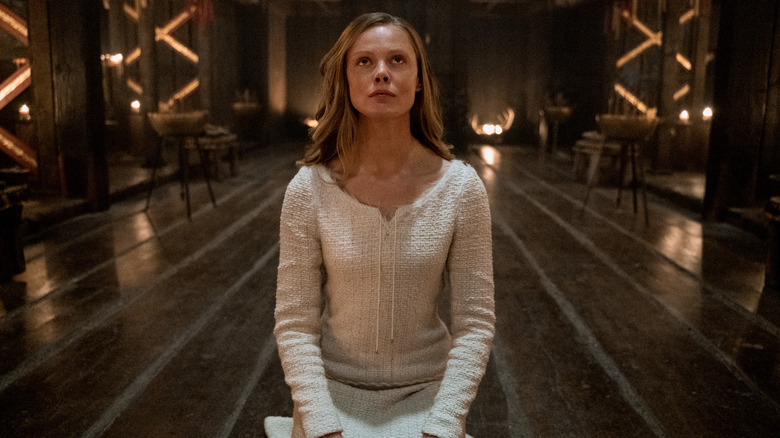The Untold Truth Of Vikings: Valhalla
Before 2013, Vikings were broadly seen as a rowdy bunch of war-mongerers with horned helmets, cool boats and blonde braided beards ... or an NFL team (Skol!) That year, however, History launched a raid on our collective perception of these ancient warriors in the form of the series Vikings.
Loosely based on the life of real Viking king Ragnar Lothbrok, the show turned the Ancient Norse from half-remembered myths to real people. It didn't shy away from their more violent practices — the show more or less told the disturbing truth about the Vikings' blood eagle execution, for example — but it also showed them as very much human, with desires, fears, romantic entanglements, religious beliefs and doubts, and even a sense of humor.
"Vikings" was History's most successful show ever. When it was announced in January 2019 that the upcoming sixth season would the last, it took less than a year for Netflix to scoop up a sequel series. In November 2019, the streaming service ordered 24 episodes of "Vikings: Valhalla," which picks up the original show, but with a major time jump. Where does this take the story, is anyone we know coming back, and what even is Valhalla? Here's the untold truth of "Vikings: Valhalla," the afterlife for the show that breathed life into historical figures (and then brutally killed them).
Vikings: Valhalla is set 100 years in Vikings' future
Just when you thought you had a handle on all the various descendants, relatives and acquaintances of Ragnar Lothbrok, the story jumps more than 100 years into the future. According to a press packet provided by Netflix, "Vikings: Valhalla" begins in the year 1002, kicking off with a "particular historical event." That could be the Viking attack on London Bridge led by Olaf Haraldsson (Jóhannes Haukur Jóhannesson), as glimpsed in the trailer, but historically that event didn't take place until several years later (if it happened at all), so it's more likely it's seen a little later in the season.
Another candidate which could kick off the series is the St. Brice's Day Massacre, which occurred on November 13, 1002, when King Aethelred II (Bosco Hogan) ordered the slaughter of all the Danish Vikings living in English territory, hoping to put an end to years of Viking raids. Instead, though, King Aethelred's actions provoked the Danish king Sweyn Forkbeard (Søren Pilmark) to increase the frequency and severity of his attacks, eventually forcing Aethelred and his queen, Emma of Normandy (Laura Berlin) into exile. Considering many of the main players in the St. Brice's Day Massacre are confirmed characters for the first season of "Vikings: Valhalla," it seems like a strong and dramatic contender to kick off the events of the series.
Whatever event marks the beginning of "Vikings: Valhalla," prepare to see a significantly more complex political landscape than the one we saw in "Vikings." In the Netflix press packet, showrunner Jeb Stuart explains what the world will look like by the time "Valhalla" begins: "The Vikings had been living in the British Isles and had settled into big areas called the Danelaw. The Danelaw had started to grow — not just with Danes, but also with Swedes, and Norwegians, and folks from all over Scandinavia. This had become a problem for the Saxon king, King Aethelred II of England. Saxon nobles were afraid that, if you went out another generation, suddenly there wouldn't be any difference between Saxons and Vikings."
Some things are changing behind the scenes of Valhalla, while others remain the same
The Vikings on "Vikings" spent most of their time engaged in power struggles, but there was only ever one man in control behind the camera. Vikings creator Michael Hirst wrote every single episode throughout all six seasons of "Vikings," so perhaps it's not surprising that he plans to be less involved in the sequel series. Hirst will still be an executive producer, alongside "Vikings" vets Morgan O'Sullivan and Jeb Stuart, the "Valhalla" showrunner whose most famous previous work is a little movie called "Die Hard."
Given the enormous time jump, we likely won't be seeing any of the familiar faces from "Vikings," unless they appear at some point as ghosts or visions. Fortunately, the same person who worked his casting magic for "Vikings" is back for "Valhalla"; Frank Moiselle acted as casting director for both shows, and has filled the new series with cast members who O'Sullivan says "bring a fresh, youthful energy to this story."
Also back for "Valhalla" is Justin Pollard, who worked as the historical consultant on "Vikings" and will be performing that same role on the spinoff. Justin will be the one digging into the obscure history being explored by the show, working to make sure it's as accurate as possible, and in fact spent months consulting with Stuart on the new series before the writing even started. And once again, "Vikings: Valhalla" will shoot in Ireland, just like the original series, bringing the same breathtaking scenery to the spinoff that fans came to expect from the original.
Vikings: Valhalla will follow three main characters
While the main character of "Vikings" was indisputably Ragnar Lothbrok, played by Travis Fimmel, "Vikings: Valhalla" will have three central characters sharing the spotlight: legendary Viking explorer Leif Eriksson (Sam Corlett), pagan shieldmaiden Freydis Eriksdotter (Frida Gustavsson), and the Norwegian prince and Viking berserker Harald Sigurdsson (Leo Suter). While Leif and Freydis are brother and sister, the pair will meet Harald for the first time during the events of the series.
Stuart says he chose to build the story around these three characters because of what they represent. "For me, they each embody different elements of the Viking spirit," Stuart said in his Netflix press interview. "Bringing Leif and Freydís — who are both Greenlanders — to Norway, to Kattegat, and embedding them in the Viking story just seemed a very natural place to go."
Centering "Vikings: Valhalla" around three characters instead of one will also help offer a broader perspective on the culture and characters, which will be important to help modern viewers relate to the story. "It's a timeless story," Stuart said when asked why Viking culture and stories are so captivating. "In a strange way — if you take massive violence out of the equation — the Vikings embody some of the elements that we still most want for ourselves. They were great explorers. They were often very inquisitive and open to learning. They were an egalitarian society ... Our characters are dealing with relationships and issues that are just as relevant today as they were a thousand years ago, and those stories will always excite and captivate us."
The title of Vikings: Valhalla is meant to reflect the end of an era
While some originally suspected that the name "Vikings: Valhalla" meant that the spinoff may give us a glimpse into the Viking afterlife, perhaps even presenting opportunities for some long-dead characters to return, we now know that the title of the series isn't necessarily about that sort of life after death. Rather, the name "Valhalla" was picked because the show depicts the events that led to the end of the Viking Age, which historically ended in 1066.
"We played with a lot of new titles and kept coming back to 'Valhalla' because the idea of the show is inherently tied to the end of this era," showrunner Jeb Stuart said in his Netflix interview. "It's all about showing this incredible time in history — and how all things eventually come to an end."
That said, we wouldn't get too worried yet about the end of the "Vikings" era. After all, since the series begins in 1002, that still gives the show more than six decades to play around with before the Viking Age comes to a historical close. Plus, of course, it's not like any period of history ever comes to a neat stop, without any overlap with the next one, so we wouldn't worry about running out of Viking legends to dramatize any time soon.
One cast member was born for their role
We often talk about how actors were "born" to play a role due to how thoroughly they pour themselves into their character, but in the case of one "Vikings: Valhalla" actor, that might literally be true. Frida Gustavsson will be playing Freydis Eriksdotter on "Valhalla," the daughter of Erik the Red and the sister of Leif Eriksson. But in an uncanny coincidence, Gustavsson's real-life father is also named Erik, and her real-life brother is also named Leif.
As if that weren't enough to raise the hairs on the back of your neck, Gustavsson's nickname in real life is also "Freydis," the same name as her character. No wonder she really threw herself into her role, reading multiple books to prepare, with her favorite being "Valkyrie: The Women of the Viking World" by J. Friðriksdóttir. Gustavsson was also an accomplished rider prior to the show, giving her an advantage during the scenes on horseback. We can only hope she also did some strength training alongside her equestrian training, since Gustavsson's costume is actually the heaviest of all the lead characters on the show, due in part to the more than 2,700 hand-cut leaves that decorate her shieldmaiden armor.
The costumes are their own characters
Anyone who has watched even a single episode of "Vikings" knows that a big part of bringing the characters to life was their intricate costumes, headed up in the show's final few seasons by costume designer Susan O'Connor Cave. For "Vikings: Valhalla," Cave is back, using her keen eye for detail to help enhance the story through costumes. For example, while the high-necked dresses that Emma of Normandy wears on the show are certainly indicative of her station and regality, they're also meant to act as her armor, conveying that although she doesn't charge into battle like a shieldmaiden, she's still a warrior in her own right. Similarly, although the devout Jarl Kåre (Asbjørn Krogh Nissen) holds no official position in the church, the silhouette of his costume is meant to evoke a cassock, a garment traditionally worn by certain Christian clergy.
Cave also incorporated the Vikings' cultural and religious shifts into her costume designs for "Vikings: Valhalla." While the overall costuming tone is similar to the original series, you may notice richer colors and more chainmail in the Viking costumes, which is meant to reflect their transition to Christianity. Color and texture also plays a big role in using the costumes to enhance the characters, with the Greenlanders' costumes meant to reflect their connection to the earth, and the Vikings' costumes overall appearing more organic, favoring wools, linens, and furs. In contrast, the Saxons will wear mostly velvets, silks, and brocades with heavy embellishment, using the costumes to highlight the stark differences between the two cultures.
Vikings: Valhalla will take history seriously
While "Vikings" developed a reputation for playing a bit fast and loose with actual history, the truth is a bit more complicated than that. Both "Vikings" and "Vikings: Valhalla" hired Justin Pollard as a historical consultant, making him responsible for doing all the research that helped inform the storylines of the show. But researching Viking history isn't as simple as just referencing old texts. As Jeb Stuart explained in his Netflix interview, "There are a million different ways to look at history ... We don't know a whole lot about the original Vikings — they didn't have a written language, so the documentation is tricky. They left us the sagas, but the sagas were written 200 years after the end of this story, and they were written by Christians. We know archeologically what has been dug up, but we're still discovering new things about Viking culture."
Obviously, it's tricky to make an authentic show about a group of people whose history was only written down centuries after the fact, and even then, only by people outside their culture. There's no one simple "correct" version to defer to, which means that many creative decisions are based on historical interpretations rather than historical facts. Still, the team behind "Vikings: Valhalla" did their best to be as true to history as they could. "Ultimately, we've made an authentic show," Stuart said. "Sometimes we've moved dates or characters around a bit, but the historical pieces are all there."
Vikings: Valhalla will feature a religious civil war
While things did begin to shift by the end of the series, the original "Vikings" mostly pitted the pagan Vikings against the English Christians, with only isolated characters like Athelstan (George Blagden) expressing any interest in bridging that gap. However, the series does feature the conversion of the Viking warrior Rollo (Clive Standen) to Christianity, at first in name only, but later on in practice as well. A hundred years later, the religious landscape in Europe looked very different, with many Vikings having followed in Rollo's footsteps and converted to Christianity.
"Vikings: Valhalla" will explore the conflict between the pagan and Christian Vikings, with both sides being well represented by the Viking families in the series. Of its three main characters, Freydis and Leif will both still worship Odin and the old gods, while Harald is a Christian. More broadly, while the Greenlander Vikings will still be pagan, the Norwegian and Danish Vikings will have largely converted to Christianity. According to Stuart, the two groups will clash in "Vikings: Valhalla" in a religious civil war. "It's a long and somewhat complex timeline," said Stuart in his Netflix press interview, "but when our story is set, Christian Vikings were mostly very sincere, very tough, and very focused on absolute and total conversion to Christianity — or violently wiping paganism off the map entirely."
